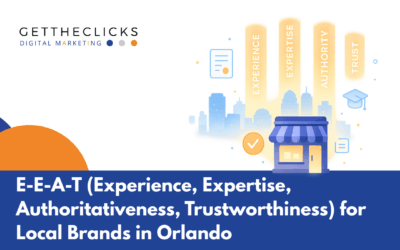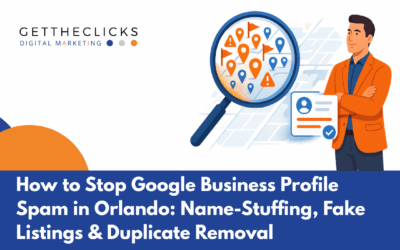If you run a local business, appearing in nearby search results is critical to attracting customers. But simply having a website or a Google Business Profile isn’t enough. To compete effectively, you need a structured, thorough local SEO audit. Hiring a professional Orlando SEO agency will simplify this process.
This checklist is designed to uncover hidden issues, fix inconsistencies, and strengthen your local search presence. Each step helps ensure you’re found by the right people at the right time, leading to more clicks, calls, and conversions. Use this guide to sharpen your local SEO and drive real business results.
Step 1: Ensure Your Business Listings Are Consistent Across the Web
Your Name, Address, and Phone number, commonly known as NAP, must be identical everywhere they appear online. Even slight variations across platforms confuse search engines and reduce your local visibility.
Start your audit by reviewing listings on Google Business Profile, Apple Maps, Bing Places, Yelp, and any industry-specific local directories relevant to your business.
Inconsistent data undermines your credibility with search engines and users. Use tools like Moz Local or BrightLocal to identify discrepancies and correct them quickly. A clean, consistent footprint across the web helps solidify your legitimacy and improve local rankings.
Step 2: Fully Optimize Your Google Business Profile
Your Google Business Profile (GBP) plays a major role in how and where your business appears in local search. Every detail matters, from the primary category to the images you upload. Make sure your business hours, contact details, and services are entirely accurate and up to date.
Complete every section, including business description, service area, and attributes. Add fresh photos and use Google Posts to keep your profile active—these steps form part of a complete guide for local SEO success.
Regularly monitor for suggested edits or policy violations that could alter your listing. An optimized, monitored profile drives engagement and boosts your chances of appearing in the local pack.
Step 3: Target Local Keywords That Align With Searcher Intent
People search using specific terms that often include locations, like “emergency dentist in Chicago” or “vegan cafe near me.” Your content and metadata should reflect how real users search. Start by identifying geo-targeted keywords that align with your services and audience.
Audit your site for keyword placement in titles, meta descriptions, headers, and on-page SEO content. Use tools like SEMrush or Google Search Console to monitor performance and discover new opportunities.
At Get the Clicks, we uncover the local keywords your ideal customers are searching for, create a keyword map that assigns search terms to specific web pages based on service and business location, ensuring you attract local traffic from your target area.
Step 4: Build Strong Location Pages With Clear Structure and Relevant Content
If your business operates in multiple locations, each one needs its dedicated landing page. These pages should include locally relevant content, not just a copied template with city names swapped. Search engines reward unique, valuable content.
Create clean URLs and ensure each page includes internal links to relevant services or blog content. Mention local landmarks, neighborhoods, or local community ties to strengthen local relevance.
Add local schema markup to enhance how these pages appear in search results. Well-built location pages help convert local customers and send stronger location signals to search engines.
Step 5: Manage Your Online Reviews Strategically for Better Local Rankings
Reviews are a key ranking factor you should be keen on when learning how to perform a local SEO audit. A business with consistent, high-quality online reviews will typically outperform one with few or poor reviews. Analyze your current review profile: look at volume, frequency, star ratings, and sentiment.
Check your presence on Google, Facebook, Yelp, and niche platforms. Encourage satisfied customers to leave reviews and respond promptly, especially to negative reviews. Use different platforms to manage outreach and notifications.
A proactive review strategy not only enhances trust but also sends positive signals to search engines that your business is valued locally.
Step 6: Optimize Your Website’s Local SEO Elements for Performance
Your local business website supports all other local SEO efforts. Make sure it loads quickly, functions well on mobile, and contains local signals throughout. Review homepage content to confirm it references your service area naturally.
Ensure your internal linking guides users from general pages to specific services or location content. Keep URLs clean, use structured data, and ensure location pages are correctly indexed.
Tools like Screaming Frog and Google Search Console can help identify technical SEO audit issues. Fast, locally optimized sites rank better and provide a stronger user experience.
Get the clicks, fine-tune every part of your website from page speed to structured data, to ensure it performs flawlessly for local search and delivers the seamless experience your customers expect.
Step 7: Build a Local Link Profile With Relevant Backlinks
High-quality, local backlinks increase your website’s authority and trustworthiness. Start by evaluating your current backlink profile. Use tools like Ahrefs or Majestic to analyze referring domains and anchor text.
Identify opportunities for links from local directories, local news sites, business associations, and sponsorships. Partner with nearby local businesses, sponsor local events, or offer guest content to local bloggers.
Conduct a competitor local link-building gap analysis to identify sources where others are gaining links but you are not. A strong local link profile supports better local SEO rankings and long-term authority in your area.
Step 8: Track User Engagement Signals That Influence Local SEO
Google evaluates how users interact with your business listings and website. Metrics like click-through rate, bounce rate, and time on site influence your rankings. Monitor insights from your Google Business Profile, especially clicks, calls, and direction requests.
On your website, track user behavior using Google Analytics. High engagement indicates relevance, while quick exits may signal poor content or usability issues.
Utilize UTM parameters to evaluate the effectiveness of GBP and other local SEO campaign efforts. By analyzing how people engage, you can optimize for both conversions and local seo performance.
Step 9: Identify and Report Local SEO Spam Tactics by Competitors
Some competitors may engage in spammy tactics like fake listings or keyword-stuffed business names to manipulate local search rankings. These practices can unfairly push legitimate businesses down in search results.
Look for duplicate listings, inaccurate business names, or listings with suspicious reviews. Use Google’s Redressal Form to report violations. Make this part of your regular local seo audits routine so you can keep your local market fair and accurate.
Regular reporting not only protects your ranking position but also reinforces the integrity of local search results overall.
Our team at Get the Clicks stays one step ahead of unethical competitors by identifying local SEO spam tactics and reporting them swiftly, so your business can rank on merit, not manipulation.
Step 10: Define Success Metrics and Continuously Monitor Your Progress
A local seo strategy is only as effective as the metrics you track. Monitor your performance using data from Google Business Profile, Search Console, and Analytics. Key metrics include impressions, clicks, direction requests, and completed goals.
Track local keyword rankings trends and review growth every month. Use dashboards to visualize progress and identify issues early. Make a local SEO audit checklist a recurring task, not a one-time fix.
When you monitor consistently, you gain the insights needed to adjust and outperform your competition over time.
Boost Your Local Visibility with Get the Clicks
Ready to turn local searches into loyal customers? Let Get the Clicks help you implement this audit and dominate your neighborhood rankings. Contact us today to start driving real, measurable results for your business.





